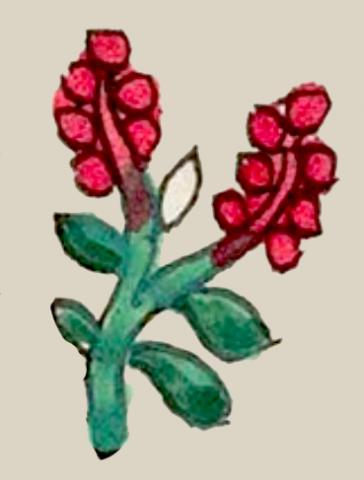capolin (Mdz33r)
This representation of a capolin (native cherry tree) is a green branch with 4–5 leaves (one apparently meant to be green, but left white?). The branch bifurcates and each part ends with a red stem and a cluster of red native cherries (six cherries on one branch and seven on the other).
Stephanie Wood
The name in Latin is Prunus Saicifolia, and it is known by other names, such as "Mexican bird cherry, capulin, capuli, capoli or capolin in Colombia and Mexico, and cerezo, detsé, detzé, taunday, jonote, puan, palman or xengua; cerezo criollo in Colombia; capulin, cereza, cereza común, or wild cherry in Guatemala; capuli in Bolivia; capuli or black cherry in Eucador." It is much like the chokecherry, found in what is now the United States. In John Ray's Historia plantarum (1686–1704) one will see these additional names: Xitoma capolin, Helo capolin, and Totocapolin, all of which appear to have Nahuatl origins. The Growables website, provides an enlarged photograph of the some branches with cherries: https://www.growables.org/information/TropicalFruit/images/CapulinEOL.JPG. This site says the plant is native to Mexico and possibly the western part of Guatemala. The fruit can be eaten raw or cooked; it has often served as a filling for corn tamales. The juice has also been fermented into an alcoholic beverage. The John Carter Brown Library has an image of the capolin from 1651, https://jcb.lunaimaging.com/luna/servlet/detail/JCB~1~1~7088~11010003:-D....
Stephanie Wood
c. 1541, or by 1553 at the latest
Stephanie Wood
Joseph Scott and Crystal Boulton-Scott

capolin, a local cherry-like tree, or the fruit of it, https://nahuatl.wired-humanities.org/content/capolin
native cherry tree or the fruit of the tree
el cerezo nativo o la fruta del árbol
Stephanie Wood
Codex Mendoza folio 33 recto, https://digital.bodleian.ox.ac.uk/objects/2fea788e-2aa2-4f08-b6d9-648c00..., image 76 of 188.
The Bodleian Libraries, University of Oxford, hold the original manuscript, the MS. Arch. Selden. A. 1. This image is published here under the UK Creative Commons, “Attribution-NonCommercial-ShareAlike 3.0 License” (CC-BY-NC-SA 3.0).

